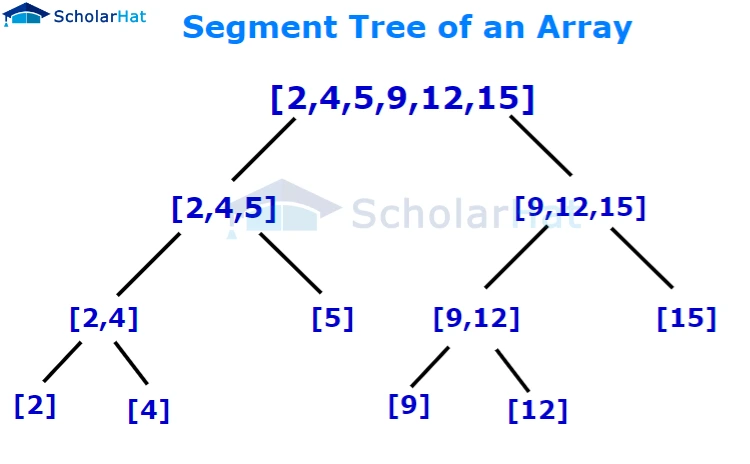Segment Tree in Data Structures
What is a Segment Tree in Data Structures?
A segment tree is a binary tree that processes range queries over an array or other linear data structure. It follows a divide-and-conquer strategy. It divides an array or range into smaller segments, each carrying a part of the original data, forming a tree-like hierarchy. Each node corresponds to a segment or range of array elements.

Basic Operations of Segment Trees
The following are the basic operations of Segment Trees:
- Update
- Query
Update
The update operation accepts both the new value to be set and the matching index. After updating the tree array, it must apply comparable modifications to the actual segment tree.
Query
The query() function accepts the query's boundaries, l and r, as inputs and returns the sum of the elements in the array that fall inside these limits.
Working Principle of Segment Trees
- Segment trees use divide and conquer.
- Divide array segments in half at each level.
- Recursively divides until the lower and upper boundaries are equal.
- The structure resembles a binary tree.
Complexity Analysis of Operations on Segment Trees
Time Complexity

Space Complexity
A segment tree has a space complexity of O(n).
Applications of Segment Trees
- Interval Scheduling: Effectively schedules non-overlapping intervals.
- Range-based statistics: Determines variance, standard deviation, and percentiles.
- Image Processing: Separates images based on color or texture.
Advantages of Segment Trees
- Efficient Range Queries: Run range queries in O(logn) time.
- Dynamic Updates: Handle updates with logarithmic temporal complexity.
- Versatility: Capable of handling a variety of data kinds using appropriate methods.
- Space Efficiency: Provide an overall space-saving solution.
- Range Decomposition: Arrays are naturally decomposed to allow for efficient recursive processing.
Disadvantages of Segment Trees
- Space Complexity: The construction of segment trees necessitates more space.
- Construction Time: Building segment trees can be time-consuming, particularly for big arrays.
- Updates and Modifications: Changing individual items may necessitate traversing several tree nodes.
- Complex Implementation: Because of the complexities involved in indexing and recursion, segment trees can be difficult to implement.


